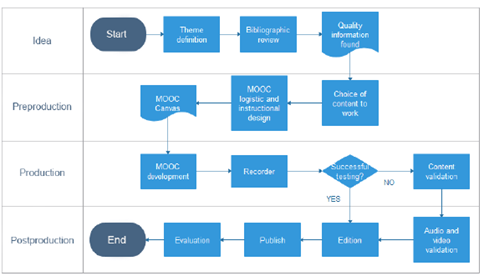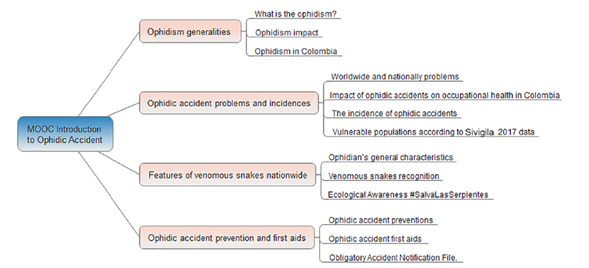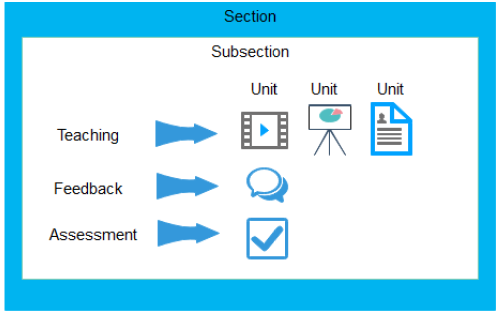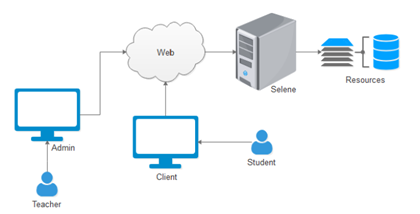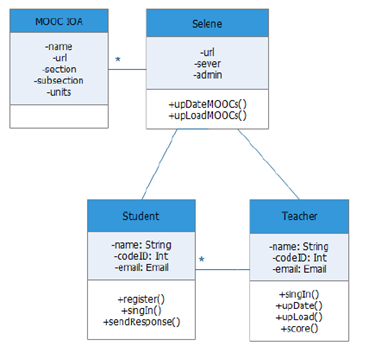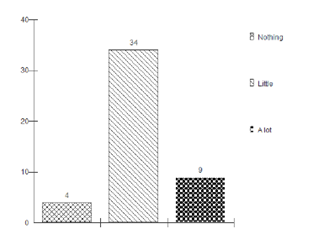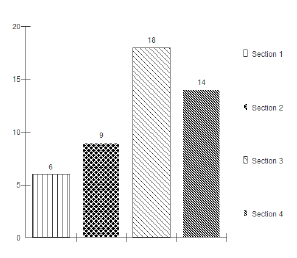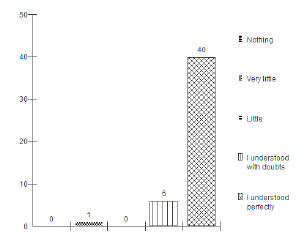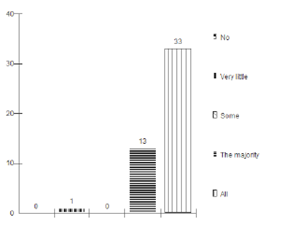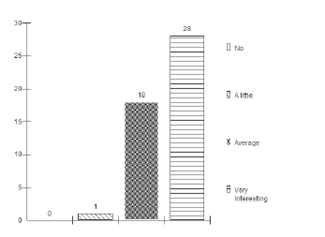INTRODUCTION
Colombia faces critical challenges in the education quality system due to the levels of social inequality [1]. There are still some marginal areas where education, housing and health are available only for a few. In these areas, health training occurs a couple times a year and, of course, ophidic accident training is usually neglected. An education focused on this area might help reduce morbidity and mortality caused by this issue.
All across the world, ophidic accidents are considered an unattended tropical disease that affects approximately 5,4 million people per year [2]. In Colombia, 5,066 accidents were recorded [3] and up to two emergencies were reported due to a shortage of anti-ophidian serum, when its production is approximately 20,000 vials per year [4].
This data exposes a problem faced by health professionals due to the lack of an adequate amount of anti-ophidian serum vials and a permanent training related to this issue. At the same time, there is inadequate knowledge on essential matters such as how to fill out mandatory notification forms, the recognition of venomous and non-venomous snakes in each region and the correct application of first aid.
At the national level, every fundamental and minimum principle guarantee of any worker is established in the right to training according to Article 53 and 54 of Colombia’s Political Constitution of 1991 [5].
Vocational training should be imparted frequently and following regulations. It must also comply fully with its obligations under Law 1122 (Cap VI: Public Health), Art. 32: where it is established that public health is constituted by the set of policies that seek to guarantee the population’s health in an integrated manner through actions of salubrity, directed both individually and collectively. Art. 33 lay down the importance of the attention and prevention of the main risk factors for health as well as the promotion of healthy conditions and lifestyles, strengthening the community capacities and encouraging the different territorial levels to act [6].
In 2016, the INS recognized the need to carry out different education strategies for health personnel, taking into account their requirements and occupations implying permanent training and updating programs [7]. In spite of all these laws, Colombia has not yet complied with them effectively. For this reason, there are flaws in the training on the ophidic accident and it is necessary to begin to venture into an innovative and massive modality throughout the Colombian territory: MOOCs.
1. METERIALS AND METHODS
1.1 MOOC Construction on Ophidic Accidents
An exhaustive review of secondary information on Ophidic Accidents was carried out at the national and departmental levels [8-21].
The MOOC was designed in the canvas model: general description, the course’s object audience, pedagogical approaches, objectives, competencies, learning contents, evaluation activities and complementary technologies. For the figure elaborations of MOOC construction, was used the online tool http://www.diagrams.net/
1.2 MOOC Recording
The study involved a television studio at University of Cauca, a camera (Sony FS7), sound (Sony UWP-D11), teleprompter, tripod (Manfrotto 504HD), 5 lights (Ikan Lyra 1x1) among other equipment, arranged by the project MOOC Mentes and MOOC MAKER to make high-quality videos
1.3 Location
The Biomedical Research Center facilities at the University of Cauca - Vivarium and green areas of the University of Cauca were the filming locations.
1.4 Snake species and herpetological equipment
Serpents: Bothrops asper, Bothropsayerbei, Bothrops rhombeatus, Bothriechis schlegelii, Bothrocophias colombianus, Lachesis acrochorda, Micrurus mipartitus popayanensis and Lampropeltis triangulum.
In order to handle the snakes, the following was used: snakes’ herpetological extendable hooks Midwest Tongs (MIDW-100-CL-HK-BLUE), professional herpetological snake hooks Midwest Tongs (MIDW-100-PSH), big friendly foldable pincer Midwest Tongs (MIDW-100-GG-S-T40-CL), kevlar gloves, forceps and 6-gauge plastic for the snakes’ immobilization.
1.6 Validation of the MOOC Introduction to Ophidic Accident
Initially, the socialization of the MOOC Introduction to Ophidic Accident (IOA) course was executed for 47 people, setting the objectives of the course and learning the methodology and each of the sections covered by the MOOC. The socialization aspect was followed by a survey of 13 questions in order to measure the level of knowledge, importance, interest, relevance and understanding of the topics. The BioEstat 5.3 program was used to collect the data and figure elaborations.
1.7 Different bibliographic reviews on training information
Different training strategies about ophidic accidents were reviewed, including virtual courses, a course on accidents by venomous animals of Cevap-Unesp [22], and a course handling of accidents caused by venomous animals from INS [23]. Additionally, information materials of on-site courses: a program for the prevention and attention improvement of patients who suffered ophidic accidents in 27 Municipalities of Cauca [24], and a breeding and handling course on experimental animals of toxinological interest [25]. A comparative table that included different highlights between these studies and a MOOC was made afterwards.
2. Results
2.1 Creation of MOOC
The creation process of the MOOC IOA was obtained from the diagram shown in figure 1. This diagram shows the process framed in 4 fundamental stages: idea, preproduction, production and postproduction. In these stages, decision-making activities such as design, content, resources and all kinds of pedagogical and technological variables that are involved in the process were carried out.
Therefore, the secondary information consulted allowed to choose the introductory themes of the MOOC on Ophidic Accident designed, using the MOOC Canvas model (table 1 and table 2).
Table 1 Design of MOOC Introduction to Ophidic Accident using the MOOC Canvas model (Available resources)
| Available resources | |
|---|---|
| 1. Human Resources (Dedication time) | Jimmy Alexander Guerrero, Biologist, PhD. (6 hours) Santiago Ayerbe, MD Toxinologist (2 hours). Angie Marcela Rengifo, Biologist (20 hours) Mary L. Bueno Ospina, Biologist (20 hours). Luis Alejandro Cruz Ordóñez, Electronic Engineer (2 hours) |
| 2. Intellectual Resources | Bibliographic material (scientific articles, books, manuals and ophidic accident folding). Videos (Unicauca TV studio and CIBUC). Snake photos (CIBUC). |
| 3. Equipment | Personal computers, cameras, lights, microphones and recording set were used to develop the MOOC. |
| 4. Platform | The MOOC was developed on the Selene platform of the University of Cauca, which was composed of texts, multimedia and Office tools. |
Source: own elaboration
Table 2 Design of MOOC Introduction to Ophidic Accident using the MOOC Canvas model (Design decisions)
| Design decisions | |
|---|---|
| 5. General description | Name: Introduction to Ophidic Accident Duration: 4 weeks Dedication: 8 hours per week Field or area: Health and biological sciences |
| 6. Tarjet learners | Students to whom it is addressed Health professionals and technicians. Professionals in biological sciences at national level. Student motivation Training on Ophidic Accidents |
| 7. Pedagogical approaches | Knowledge transfer and active learning |
| 8. Objectives and Competences | a. Know what ophidism is b. Recognize the problematic and incidence of ophidic accidents at a national level. c. Distinguish the distribution, habitat and differences between venomous and non-venomous snakes. d. Acquire the basic knowledge on prevention, first aid and due diligence of compulsory notification cards (National Public Health Surveillance System - Sivigila) about ophidic accidents. |
| 9. Learning contents: | Section 1. Ophidism generalities Section 2. Ophidic accident problems and incidences Section 3. Features of venomous snakes nationwide. Section 4. Ophidic accident prevention and first aids |
| 10. Assessment activities | Multiple choice tests. Video situations faced by victims of ophidic accidents that show the right decision. Choose the correct characteristics according to the presented image. Organization of first aid by step. Correlate concepts. |
| 11. Complementary technologies | Facebook (course promotion to specific groups) Blog YouTube (free online videos) Instagram Broadcasters The institutional channel of Cauca University |
Source: own elaboration
2.2 Learning contents
The MOOC is composed of four sections, from which the different subsections and units of the course are derived. Figure 2 shows an information diagram deploying these contents and their hierarchical organization.
Section 1. Ophidism generalities
This section describes how to learn about ophidism: definition, characteristics and levels. It also talks about a very important issue for victims of ophidic accidents in the country, the flaws in health systems, the incidence of non-medical practices and the proper use of anti-ophidian serum.
Finally, the lack of knowledge on ophidism in the country must be recognized andtherefore the inconsistencies in the serum production and the number of cases reported.
Subsection 1.1. What is ophidism?
Unit 1.1.1. Definition of ophidism.
Unit 1.1.2. Characteristics of ophidism.
Unit 1.1.3. Levels of ophidism.
Subsection 1.2. Ophidism’s impact
Unit 1.2.1. Failures in the health systems.
Unit 1.2.2. Incidence of non-medical practices.
Unit 1.2.3. Poor use of anti-venom serum.
Unit 1.2.4. Production of antiophidic serum in the country.
Subsection 1.3. Ophidism in Colombia
Unit 1.3.1. Unawareness of an ophidic accident.
Section 2. Ophidic accident problems and incidences
People will learn about the problems faced at a global and national level from ophidic accidents as it is an unattended tropical disease that affects millions of people every year, constituting a serious public health problem in several countries. In addition, the impact of ophidism on occupational health and its incidence in the most vulnerable population from this type of accidents has been discussed.
Subsection 2.1. Worldwide and national problems
Unit 2.1.1 Panorama according to the World Health Organization.
Unit 2.1.2 National Overview.
Subsection 2.2. Impact of ophidic accidents on occupational health in Colombia
Unit 2.2.1. World State.
Unit 2.2.2. State in Colombia.
Subsection 2.3. The incidence of ophidic accidents
Unit 2.3.1. Accident figures.
Subsection 2.4. Vulnerable populations according to Sivigila 2017 data
Unit 2.4.1. Occurrence of ophidic accidents by area of origin, gender, type of social
security and circumstances.
Unit 2.4.2. Occurrence of ophidic accidents by ethnic origin, region and munici- pality of origin.
Unit 2.4.3. Occurrence of ophidic accidents according to the location of the bite, type of initial care and non-medical practices.
Unit 2.4.4. Occurrence of ophidic accidents due to the severity of the case, use of anti-venom serum and genus of the snake.
Section 3. Features of venomous snakes nationwide
This section explains the general characteristics of the snakes, differentiating a venomous snake from a non-venomous one for humans. A representation of the most basic knowledge about snake families, their dentition type and geographical distribution. These are fundamental aspects to prevent an accident caused by this type of animal, to give a good first aid in case of an accident and to carry out an adequate treatment in the health centre. Additionally, there is a unit on ophidian conservation and auditory learning with different situations faced by the victims of ophidian accidents.
Subsection 3.1. Ophidian’s general characteristics
Unit 3.1.1. Wealth of snakes.
Unit 3.1.2. Snake morphology.
Unit 3.1.3. Type of scales.
Unit 3.1.4. Feeding snakes.
Unit 3.1.5. Do you know how snakes detect their prey?
Unit 3.1.6. Do you know where the snake venom is produced and what it is for?
Subsection 3.2. Venomous snake recognition
Unit 3.2.1 Differences between Vipers, Snakes and Boas.
Unit 3.2.2. Differences between true and false Corals.
Unit 3.2.3. Type of teething.
Unit 3.2.4. Geographical distribution of venomous snakes.
Subsection 3.3. Ecological Awareness #SalvaLasSerpientes (#SavetheSnakes)
Unit 3.4.1. Snakes play a fundamental role in the ecosystem.
Section 4. Ophidic accident prevention and first aids
To prevent an ophidic accident, issues of vital importance were approached, on how to face several situations generally presented in this field where most of the affected people included those who must move in places of snake development. In addition, guidelines for first aid were given: What should not be done? How to carry out a correct victim’s attention? Finally, it is essential to count with health personnel trained to face this type of accidents and that knows how to correctly fill out the notification forms necessary to obtain the real impact of ophidism in our country. It might give rise to accurate data for people in charge of the anti-ophidian serum production in demand.
Subsection 4.1. Prevention of ophidic accident
Unit 4.1.1. Recommendations to prevent ophidism in rural areas.
Unit 4.1.2. What do I do if I encounter a snake?
Unit 4.1.3. What would you do?
Subsection 4.2.Ophidic accident first aids
Unit 4.2.1. Correct first aid for ophidism.
Unit 4.2.2. Things that should not be done in the face of an ophidic accident.
Subsection 4.3. Obligatory Accident Notification File.
Unit 4.3.1. Sivigila
Unit 4.3.2. Correct completion of the compulsory notification form for an ophidian accident.
2.3 Platform exploration
The course is hosted as an educational resource in virtual environments on the Selene platform of the University of Cauca. This platform has a structure focused on massive and open environments, in which different resources for students can be arranged. figure 3 shows this information.
Each unit contains videos with definitions of concepts and various themes about ophidism, and students are offered texts and reviews of articles or books that help to consolidate the knowledge acquired. Students can access forums as a feedback resource and assessment activities to measure the level of knowledge.
2.4 Software architecture model
The MOOC to be hosted on the web has a software architecture, which relates the elements involved and establishes different roles for the people in the course. figure 4 shows the software architecture diagram for this MOOC.
The elements belonging to the MOOC can also be identified as specific classes, which are composed of attributes and methods. For this MOOC IOA, we have also wanted to propose a class diagram to show this information (figure 5).
2.5 Validation of MOOC IOA
With the surveys carried out, the pertinence and interest of the MOOC IOA themes were evaluated (figures 6-12 and table 3).
Table 3 Evaluation of the relevance and interest of the MOOC IOA course
| MOOC Validation Survey- Introduction to Ophidic Accident | ||
|---|---|---|
| 1 Are the topics adequate to have introductory knowledge about an Ophidic Accident? | Yes No | 100% 0% |
| 2 Do you think that training on this subject is important? | Yes No | 100% 0% |
| 3 Would you like to see other videos of this style? | Yes No Maybe | 91.5% 0% 8.5% |
| 4 Would you like to do the MOOC IOA once it is available? | Yes No Maybe | 87.2% 0% 12.8% |
| 5 Would you recommend this MOOC for people in your field of operation? | Yes No | 97.9% 2.1% |
| 6 Do you think that the MOOC IOA could be an alternative solution to the lack of training on this issue at the national level? | Yes No Maybe | 74.5% 0% 25.5% |
Source: own elaboration.
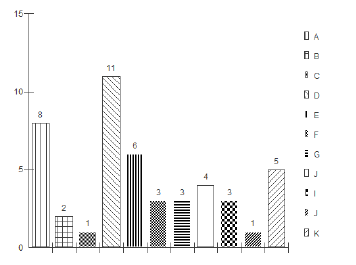
Note. A. More specific Ophidic Accident Management. B. Ophidic Accidents in Cauca. C. Learn about MOOC. D. Medical treatment and clinical cases. E. Biodiversity and distribution of venomous snakes. F. Accidents with other venomous animals and plants. G. Traditional knowledge about plants to treat Ophidic Accidents. H. Composition of the venom and how it acts in the organism. I. Production and effect of anti-venom serum. J. Equipment for handling reptiles K. Did not respond. Source: own elaboration
Figure 11 Thematic proposal for a second part of the MOOC IOA course
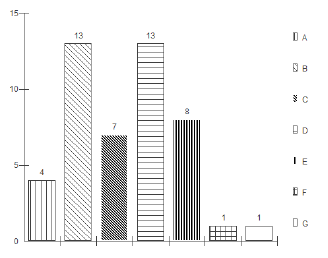
Note. A. MOOCs cannot replace the trainings: Questions are not resolved. B. Positive impact: Continuous self-training. C. Greater accessibility to knowledge. D. Positive impact: Complementing what has been learned in the traditional classroom in a more dynamic way. E. Positive impact: Innovative pedagogical model. F. Positive impact as long as the defection factor is controlled. G. Did not respond Source: own elaboration.
Figure 12 Impact level of the MOOC courses on higher education
2.6 Compare the MOOC with other virtual and face-to-face training
A comparative table was made, highlighting the differences between the different training courses on Ophidism. table 4 presents the advantages and disadvantages for each of the characteristics.
Table 4 Comparison of the Introduction to Ophidic Accident MOOC between virtual courses (INS) and face-to-face training (GIHT Experiences) in Colombia
| Characteristic | Introduction to Ophidic Accident MOOC | Virtual course on prevention and management of accidents caused by poisonous animals (INS) | On-site training (GIHT experiences) |
|---|---|---|---|
| Accessibility | People with internet connections and handle basic training in computer tools | People with previous knowledge about the course or enrolled in advance (20 days) and who handle basic training in computer tools | People with the availability of displacement to training centres or training areas in Rural and urban communities using or without a basic computer and internet tools. |
| Pedagogical tools | Videos, audios, forums, social networks such as interactivity forms, pdf files, presentations and articles. | Videos, pdf files, page links, teacher support at specific times and videoconferences. | PowerPoint presentations, cards, folding and posters. |
| Availability | Extended time. Started date, but not completion deadline. | Short time, specific dates to begin and finish the course. | Dates and schedules established to start and finish the course, without flexibility. |
| Abidance | Other MOOCs realization on poison and specific actions of ophidism treatments. | No continuous options since it covers in a general way the relevant theme of the ophidism. | Programme continuity depending on the budget assigned. Limitations due to the difficulties in accessing the chosen areas |
| Quotas | Unlimited | Limitaded | Limitades |
| Investment time | Self-study hour’s distribution at your own pace (8 hours per week). | Dedication time established per week | One or two days in each selected area during the Program implementation, depending on the instructor’s disposition. |
| Dropout percentage | 90% | 60% | 10% |
| User requirements | Health professionals and at risk of accidents. | Health professionals and at risk of accidents. | The community at risk and specific professionals. |
| Theme specificity | High | Medium | High |
| Fees | Free | Free | Free/Payment |
| Evaluation mode | Summative and formative assessments, multiple choice tests, peer evaluation and interactive forums. | Multiple choice evaluation, peer evaluation and interactive evaluation. | Pre-course evaluation with 20 basic questions and post-course evaluation to estimate the percentage gain per pair, multiple choice tests and / or development. |
Source: own elaboration.
3. DISCUSSION
The MOOC IOA is an online, open and massive course, designed for an unlimited number of participants without entry requirements and completely free access to anyone with a computer and internet conexion. Towards the middle of the current year, the MOOC IOA began with the creation and content reviews that make it the pioneer in Colombia since it deals with specific ophidism topics and allows health professionals and biological and research scientists to be faced with this type of accident. Moreover, it created solid foundations on this topic in order to improve its awareness, prevention and first aid features.
The formative phenomenon of the MOOCs created a great expectation among the international academic community and, like any innovation, it generated followers and opponents. The former considered it as a new alternative formative modality that might progressively replace the classic model of university education, while the latter expressed serious criticisms and exposed that MOOCs will never be able to match up to the traditional university quality [26]. What is certain is that MOOC IOA aims to train people in difficult situations and give access to the university education for those who have travel inconveniences. It might be an immediate and massive alternative in an environment where knowledge is often nonexistent.
Moreover, the interactive and collaborative development of the MOOC depends on all the participants in regard to the development queries from each available forum in each section. This type of training in which there is no teacher support is based on the pedagogical principles of connectivism. According to Siemens [27], “this theory holds that learning and knowledge are based on the diversity of opinions. Connectivism is a process of connecting specialized nodes or sources of information. This cycle of knowledge development allows students to stay updated in their field through the connections they have learned.”
Day by day, MOOCs are a more universal, digital and mobile network that seeks to achieve education goals like reaching a mass audience and nurture their contributions using multiple available and accessible resources [28]. They differ from the traditional training forms, which are not very dynamic, poorly accessible and do not support a mass audience given that face-to-face training as well as virtual courses are for a limited number of people.
Another important MOOC feature is the way it works with content since it follows a methodology based on the video production and the collaborative students’ work [29]. It produces several short videos, friendly and enjoyable for learning. The videos used in the virtual training have a long duration, which means that they are not so attractive and students may lose interest after a certain amount of time. They provide links to websites, teacher support at specific times and video conferences helping the student to feel like they are in a classroom. As for the face-to-face course, it could become very monotonous having only PowerPoint presentations, tokens, folding, and posters; the loss of interest will depend on the instructor’s enthusiasm.
On the other hand, conventional courses tend to be guided by a teacher or tutor who gives guidelines on the methodology of the courses, assignments and specific delivery dates. The virtual courses and the limited time to perform the tasks leads the student to look at the contents quickly and only care about the course evaluation and finish the course in an appropriate time, leaving aside the proposed learning competencies. This does not apply to MOOC because the courses are predetermined in the order that allows each learner to advance at their own pace. The majority of the population is not accustomed to self-regulation in learning. The percentage of attention is very low in extensive courses and the dropout rate is high [30]. The MOOC IOA aims to change this situation, including various strategies such as using teaching materials, interactive videos, readings and audios, debunking myths about snakes and giving curious facts in the unit “Did you know?”. In sum, allowing the student to develop an affinity with the topics and, that way, remain in the course.
The way in which the knowledge acquired in the MOOC IOA will be evaluated aims to be very didactic: the use of multimedia aids, for example interactive videos where a person can choose the right path in a given situation. The conventional multiple- choice tests will also be carried out: choose the correct characteristics according to the presented image; correlate concepts; organize first aid by steps. Unlike other types of virtual and face-to-face courses where the evaluation methods are usually carried out by pairs, multiple-choice tests, oral exams and, in rare occasions, interactive evaluations.
Through validation, it was possible for different people to know the structure of the MOOC IOA. This indicated that a large number of them have little knowledge about this topic. The content of the MOOC seemed appropriate, clear and attractive; this must be because the course is designed to capture the attention of the students using didactic and entertaining classes, through videos, audios with real problems, images that help the rapid retention of information and key texts to learn about the ophidism. This gives the student the possibility to create awareness or inquire more about the different topics.
Respondents highlight the importance of training on ophidism since it is scarcely available. A large part of the Colombian population lacks the basic knowledge about this type of accident and ignores the characteristics that help differentiate a venomous snake from a non-venomous one. The third section, regarding the distinction of snake characteristics received the most attention. The interest in this section increased when it was made clear that not all snakes are venomous to humans and that snakes play a fundamental role in maintaining the balance of other species that can become pests in crops.
The videos presented to the public and the language used were clear and perfectly understood; 60 % of the respondents felt that the videos were very interesting and 91 % said that they would like to see other videos of that same style in the course. The videos have a dynamic that is easy to understand, with concise concepts and a duration of approximately one and a half minutes and they deal with current issues and present the guidelines for the prevention of ophidic accidents and correct first aid in the case of ophidism. Also, 87 % would like to do the MOOC IOA and 98 % of the respondents would recommend the course to people in their line of action. The participants showed great interest in carrying out the MOOC IOA and in the future, they would like to have a second course on medical treatment and clinical cases, which would be somewhat more specialized for the health sector and of great importance because most of the health care staff that faces these cases has no knowledge about treatment.
Finally, one of the weaknesses of health in Colombia could be found in the limited training resulting from the significant reduction in economic resources, the limited quotas and the difficult access to specific areas, where there is a great lack of knowledge about ophidism. MOOCs generate a broad and precise solution to this problem.
CONCLUSIONS
The IAO MOOC course, under validation process, was considered as an excellent tool of new training methods enabling students to advance by themselves.
Besides reaching health professionals and related sciences, the IAO MOOC course enables training for the general public, including social leaders, rulers, and decision-makers.
The use of technology resources offered to education in engineering and telecommunications is a significant advantage overcoming the availability, opportunity, location, and time limitations in acceding to training on a public health problem, as is the case of ophidism.
Interdisciplinary teams offer the best education and training solutions to complex problems in health and other knowledge areas, that requiring easy accessibility and availability at all times.














